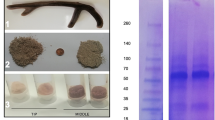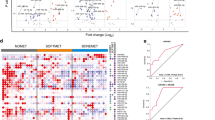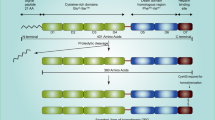Abstract
Deer antlers are a bony organ solely able to acquired distinct unique attributes during evolution and all these attributes are against thus far known natural rules. One of them is as the fastest animal growing tissue (2 cm/day), they are remarkably cancer-free, despite high cell division rate. Although tumor-like nodules on the long-lived castrate antlers in some deer species do occur, but they are truly benign in nature. In this review, we tried to find the answer to this seemingly contradictory phenomenon based on the currently available information and give insights into possible clinic application. The antler growth center is located in its tip; the most intensive dividing cells are resident in the inner layer of reserve mesenchyme (RM), and these cells are more adopted to osteosarcoma rather than to normal bone tissues in gene expression profiles but acquire their energy mainly through aerobic oxidative phosphorylation pathway. To counteract propensity of neoplastic transformation, antlers evolved highly efficient apoptosis exactly in the RM, unparalleled by any known tissues; and annual wholesale cast to jettison the corps. Besides, some strong cancer suppressive genes including p53 cofactor genes and p53 regulator genes are highly positively selected by deer, which would have certainly contributed to curb tumorigenesis. Thus far, antler extracts and RM cells/exosomes have been tried on different cancer models either in vitro or in vivo, and all achieved positive results. These positive experimental results together with the anecdotal folklore that regular consumption of velvet antler is living with cancer-free would encourage us to test antlers in clinic settings.
This is a preview of subscription content, access via your institution
Access options
Subscribe to this journal
Receive 12 print issues and online access
$259.00 per year
only $21.58 per issue
Buy this article
- Purchase on Springer Link
- Instant access to full article PDF
Prices may be subject to local taxes which are calculated during checkout




Similar content being viewed by others
Data availability
Data are available from the corresponding authors upon reasonable request.
References
Tomasetti C, Vogelstein B. Cancer etiology. Variation in cancer risk among tissues can be explained by the number of stem cell divisions. Science. 2015;347:78–81.
Carbone M, Amelio I, Affar EB, Brugarolas J, Cannon-Albright LA, Cantley LC, et al. Consensus report of the 8 and 9th Weinman Symposia on Gene x Environment Interaction in carcinogenesis: novel opportunities for precision medicine. Cell Death Differ. 2018;25:1885–904.
Wu S, Powers S, Zhu W, Hannun YA. Substantial contribution of extrinsic risk factors to cancer development. Nature 2016;529:43–47.
Boddy AM, Kokko H, Breden F, Wilkinson GS, Aktipis CA. Cancer susceptibility and reproductive trade-offs: a model of the evolution of cancer defences. Philos Trans R Soc Lond B Biol Sci. 2015;370:20140220.
Fredrickson TN. Ovarian tumors of the hen. Environ Health Perspect. 1987;73:35–51.
Johnson PA, Giles JR. The hen as a model of ovarian cancer. Nat Rev Cancer. 2013;13:432–6.
Kotsopoulos J, Lubinski J, Gronwald J, Cybulski C, Demsky R, Neuhausen SL, et al. Factors influencing ovulation and the risk of ovarian cancer in BRCA1 and BRCA2 mutation carriers. Int J Cancer. 2015;137:1136–46.
Goss RJ. Future directions in antler research. Anat Rec. 1995;241:291–302.
Li C, Suttie JM, Clark DE. Morphological observation of antler regeneration in red deer (Cervus elaphus). J Morphol. 2004;262:731–40.
Landete-Castillejos T, Kierdorf H, Gomez S, Luna S, Garcia AJ, Cappelli J, et al. Antlers - Evolution, development, structure, composition, and biomechanics of an outstanding type of bone. Bone 2019;128:115046.
Li C, Fennessy P. The periosteum: a simple tissue with many faces, with special reference to the antler-lineage periostea. Biol Direct. 2021;16:17.
>Li C Annual antler renewal: a unique case of stem cell-based mammalian organ regeneration. 19th Annual Queenstown Molecular Biology Meeting. 2009; Queenstown. p. 38.
Guo Q, Liu Z, Zheng J, Zhao H, Li C. Substances for regenerative wound healing during antler renewal stimulated scar-less restoration of rat cutaneous wounds. Cell Tissue Res. 2021;386:99–116.
Li C, Chu W. The regenerating antler blastema: the derivative of stem cells resident in a pedicle stump. Front Biosci (Landmark Ed). 2016;21:455–67.
Fennessy P, Corson I, Suttie J, Littlejohn R Antler growth patterns in young red deer stags. The Biology of Deer. 1992; Mississippi State University: Springer-Verlag: pp. 487-92.
Gao Z, Li C. The study on the relationship between antler’s growth rate, relative bone mass and circulation testosterone, estradiol, AKP in sika deer. Acta Vet Zootech Sin. 1988;19:224–31.
Goss RJ. Problems of antlerogenesis. Clin Orthop Relat Res. 1970;69:227–38.
Chapman DI. Antlers-bones of contention. Mammal Rev. 1975;5:121–72.
Banks W, Newbrey J. Light microscopic studies of the ossification process in developing antlers. Antler Development in Cervidae. Kingsville: Caesar Kleberg Wildl. Res. Inst.; 1982. p. 231–60.
Li C, Clark DE, Lord EA, Stanton JA, Suttie JM. Sampling technique to discriminate the different tissue layers of growing antler tips for gene discovery. Anat Rec. 2002;268:125–30.
Sadighi M, Haines SR, Skottner A, Harris AJ, Suttie JM. Effects of insulin-like growth factor-I (IGF-I) and IGF-II on the growth of antler cells in vitro. J Endocrinol. 1994;143:461–9.
Elliott JL, Oldham JM, Ambler GR, Bass JJ, Spencer GS, Hodgkinson SC, et al. Presence of insulin-like growth factor-I receptors and absence of growth hormone receptors in the antler tip. Endocrinology 1992;130:2513–20.
Elliott JL, Oldham JM, Ambler GR, Molan PC, Spencer GS, Hodgkinson SC, et al. Receptors for insulin-like growth factor-II in the growing tip of the deer antler. J Endocrinol. 1993;138:233–42.
Suttie JM, Gluckman PD, Butler JH, Fennessy PF, Corson ID, Laas FJ. Insulin-like growth factor 1 (IGF-1) antler-stimulating hormone? Endocrinology 1985;116:846–8.
Suttie JM, Fennessy PF Growth promoting hormones and antler development. 18th Congress, IUGB. 1987; Krakow. pp. 194-5.
Wang Y, Zhang C, Wang N, Li Z, Heller R, Liu R, et al. Genetic basis of ruminant headgear and rapid antler regeneration. Science. 2019;364:eaav6335.
Ludlow AT, Wong MS, Robin JD, Batten K, Yuan L, Lai TP, et al. NOVA1 regulates hTERT splicing and cell growth in non-small cell lung cancer. Nat Commun. 2018;9:3112.
Li C, Suttie JM. Light microscopic studies of pedicle and early first antler development in red deer (Cervus elaphus). Anat Rec. 1994;239:198–215.
Li C, Suttie JM, Clark DE. Histological examination of antler regeneration in red deer (Cervus elaphus). Anat Rec A Discov Mol Cell Evol Biol. 2005;282:163–74.
Lombard LS, Witte EJ. Frequency and types of tumors in mammals and birds of the Philadelphia Zoological Garden. Cancer Res. 1959;19:127–41.
Griner LA. A review of necropsies conducted over a fourteen-year period at the San Diego Zoo and San Diego Wild Animal Park. Pathology of Zoo Animals. 1983.
Annibaldi A, Widmann C. Glucose metabolism in cancer cells. Curr Opin Clin Nutr Metab Care. 2010;13:466–70.
Warburg O. On the origin of cancer cells. Science 1956;123:309–14.
Hanahan D, Weinberg RA. Hallmarks of cancer: the next generation. Cell 2011;144:646–74.
Bergers G, Benjamin LE. Tumorigenesis and the angiogenic switch. Nat Rev Cancer. 2003;3:401–10.
Wu H, Ding Z, Hu D, Sun F, Dai C, Xie J, et al. Central role of lactic acidosis in cancer cell resistance to glucose deprivation-induced cell death. J Pathol. 2012;227:189–99.
Vander Heiden MG, Cantley LC, Thompson CB. Understanding the Warburg effect: the metabolic requirements of cell proliferation. Science 2009;324:1029–33.
Goss RJ. Deer Antlers. Regeneration, Function and Evolution. New York: Academic Press; 1983.
Bubenik GA Endocrine regulation of the antler cycle. Antler Development in Cervidae. Kingsville: Caesar Kleberg Wildl. Res. Inst.; 1982. pp. 73-107.
Goss RJ. Tumor-like growth of antlers in castrated fallow deer: an electron microscopic study. Scanning Microsc. 1990;4:715–20. discussion 720-711
Kierdorf U, Kierdorf H, Schultz M, Rolf HJ. Histological structure of antlers in castrated male fallow deer. Discoveries Mol Cell Evolut Biol. 2004;281:1352–62.
Goss RJ. Inhibition of growth and shedding of antlers by sex hormones. Nature. 1968;220:83–85.
Guo M, Hay BA. Cell proliferation and apoptosis. Curr Opin Cell Biol. 1999;11:745–52.
Colitti M, Allen SP, Price JS. Programmed cell death in the regenerating deer antler. J Anat. 2005;207:339–51.
Antonsson B, Martinou JC. The Bcl-2 protein family. Exp Cell Res. 2000;256:50–57.
Suttie J, Fennessy P Recent advances in the physiological control of velvet antler growth. The Biology of Deer. 1992 Springer-Verlag. pp. 471-86.
Fennessy PF, Suttie JM, Crosbie SF, Corson ID, Elgar HJ, Lapwood KR. Plasma LH and testosterone responses to gonadotrophin-releasing hormone in adult red deer (Cervus elaphus) stags during the annual antler cycle. J Endocrinol. 1988;117:35–41.
Suttie JM, Fennessy PF, Lapwood KR, Corson ID. Role of steroids in antler growth of red deer stags. J Exp Zool. 1995;271:120–30.
Moujalled D, Strasser A, Liddell JR. Molecular mechanisms of cell death in neurological diseases. Cell Death Differ. 2021;28:2029–44.
Dasgupta S, Ghosh T, Dhar J, Bhuniya A, Nandi P, Das A, et al. RGS5-TGFbeta-Smad2/3 axis switches pro- to anti-apoptotic signaling in tumor-residing pericytes, assisting tumor growth. Cell Death Differ. 2021;28:3052–76.
Martens S, Bridelance J, Roelandt R, Vandenabeele P, Takahashi N. MLKL in cancer: more than a necroptosis regulator. Cell Death Differ. 2021;28:1757–72.
Yin K, Lee J, Liu Z, Kim H, Martin DR, Wu D, et al. Mitophagy protein PINK1 suppresses colon tumor growth by metabolic reprogramming via p53 activation and reducing acetyl-CoA production. Cell Death Differ. 2021;28:2421–35.
Li Y, Cui K, Zhang Q, Li X, Lin X, Tang Y, et al. FBXL6 degrades phosphorylated p53 to promote tumor growth. Cell Death Differ. 2021;28:2112–25.
Jin JO, Lee GD, Nam SH, Lee TH, Kang DH, Yun JK, et al. Sequential ubiquitination of p53 by TRIM28, RLIM, and MDM2 in lung tumorigenesis. Cell Death Differ. 2021;28:1790–803.
Pearson M, Pelicci PG. PML interaction with p53 and its role in apoptosis and replicative senescence. Oncogene. 2001;20:7250–6.
Kastenhuber ER, Lowe SW. Putting p53 in Context. Cell. 2017;170:1062–78.
Amelio I, Melino G. The p53 family and the hypoxia-inducible factors (HIFs): determinants of cancer progression. Trends Biochem Sci. 2015;40:425–34.
Candi E, Cipollone R, Rivetti di Val Cervo P, Gonfloni S, Melino G, Knight R. p63 in epithelial development. Cell Mol Life Sci. 2008;65:3126–33.
Chen L, Qiu Q, Jiang Y, Wang K, Lin Z, Li Z, et al. Large-scale ruminant genome sequencing provides insights into their evolution and distinct traits. Science. 2019;364:eaav6202.
Meek DW. Tumour suppression by p53: a role for the DNA damage response? Nat Rev Cancer. 2009;9:714–23.
Ma. Deer Production and Disease. Jilin Press of Science and Technology, 1998.
Kong YC, But PPH Deer: The ultimate medicinal animal (antler and deer parts in medicine). Biology of deer production. 1985 Wellington. pp. 311-24.
Fan YL, Xing Z, Wei Q. A study on the extraction separation and anticancer activity of velvet antler protein. J Economic Anim. 1998;3:27–31.
Xiong HL Extraction and isolation of activity component from velvet antler and research of its anti-tumor effect. Northwest A&F University. 2007.
Fraser A, Haines SR, Stuart EC, Scandlyn MJ, Alexander A, Somers-Edgar TJ, et al. Deer velvet supplementation decreases the grade and metastasis of azoxymethane-induced colon cancer in the male rat. Food Chem Toxicol. 2010;48:1288–92.
Hu W, Qi L, Tian YH, Hu R, Wu L, Meng XY. Studies on the purification of polypeptide from sika antler plate and activities of antitumor. BMC Complement Alter Med. 2015;15:328.
Tang Y, Jeon BT, Wang Y, Choi EJ, Kim YS, Hwang JW, et al. First Evidence that Sika Deer (Cervus nippon) Velvet Antler Extract Suppresses Migration of Human Prostate Cancer Cells. Korean J Food Sci Anim Resour. 2015;35:507–14.
Yang H, Wang L, Sun H, He X, Zhang J, Liu F. Anticancer activity in vitro and biological safety evaluation in vivo of Sika deer antler protein. J Food Biochem. 2017;41:e12421.
Tang Y, Fan M, Choi YJ, Yu Y, Yao G, Deng Y, et al. Sika deer (Cervus nippon) velvet antler extract attenuates prostate cancer in xenograft model. Biosci Biotechnol Biochem. 2019;83:348–56.
Palipoch S, Punsawad C. Biochemical and histological study of rat liver and kidney injury induced by Cisplatin. J Toxicol Pathol. 2013;26:293–9.
Chonco L, Landete-Castillejos T, Serrano-Heras G, Serrano MP, Perez-Barberia FJ, Gonzalez-Armesto C, et al. Anti-tumour activity of deer growing antlers and its potential applications in the treatment of malignant gliomas. Sci Rep. 2021;11:42.
Fleshner N. Defining high-risk prostate cancer: current status. Can J Urol. 2005;12:14–17. discussion 94-16
Gleave ME, Bruchovsky N, Moore MJ, Venner P. Prostate cancer: 9. Treatment of advanced disease. CMAJ. 1999;160:225–32.
Moreau JP, Delavault P, Blumberg J. Luteinizing hormone-releasing hormone agonists in the treatment of prostate cancer: a review of their discovery, development, and place in therapy. Clin Ther. 2006;28:1485–508.
Lamoureux F, Thomas C, Yin MJ, Kuruma H, Fazli L, Gleave ME, et al. A novel HSP90 inhibitor delays castrate-resistant prostate cancer without altering serum PSA levels and inhibits osteoclastogenesis. Clin Cancer Res. 2011;17:2301–13.
Acknowledgements
We authors thank Dr. Peter Fennessy for critically reading through the paper and helpful and constructive criticisms.
Funding
This study was supported by grants from the National Natural Science Foundation of China (No. U20A20403).
Author information
Authors and Affiliations
Contributions
CL, YL, WW, GM, RD and YS conceived the project and wrote the manuscript. All of the Authors have written, corrected and approved the submitted version.
Corresponding authors
Ethics declarations
Competing interests
GM and YS are members of the Editorial Board of Cell Death & Differentiation and of Cell Death & Disease. The authors declare no other conflict of interests.
Ethics
All the procedures carried out in the research with participation of humans were in compliance with the ethical standards of the institutional and/or national ethics committee and with the Helsinki Declaration of 1964 and its subsequent changes or with comparable ethics standards. Informed voluntary consent was obtained from every participant of the study. Animal work was according to Ministry of Health regulation, respecting ethics and safety for the mice. All authorizations were obtained for specific strains and detailed experiments.
Additional information
Publisher’s note Springer Nature remains neutral with regard to jurisdictional claims in published maps and institutional affiliations.
Rights and permissions
Springer Nature or its licensor (e.g. a society or other partner) holds exclusive rights to this article under a publishing agreement with the author(s) or other rightsholder(s); author self-archiving of the accepted manuscript version of this article is solely governed by the terms of such publishing agreement and applicable law.
About this article
Cite this article
Li, C., Li, Y., Wang, W. et al. Deer antlers: the fastest growing tissue with least cancer occurrence. Cell Death Differ 30, 2452–2461 (2023). https://doi.org/10.1038/s41418-023-01231-z
Received:
Revised:
Accepted:
Published:
Issue Date:
DOI: https://doi.org/10.1038/s41418-023-01231-z



